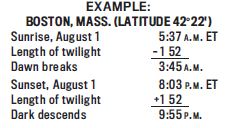THE TWILIGHT ZONE/METEOR SHOWERS
Twilight is the time when the sky is partially illuminated preceding sunrise and again following sunset. The ranges of twilight are defined according to the Sun's position below the horizon. Civil twilight occurs when the Sun's center is between the horizon and 6 degrees below the horizon (visually, the horizon is clearly defined). Nautical twilight occurs when the center is between 6 and 12 degrees below the horizon (the horizon is distinct). Astronomical twilight occurs when the center is between 12 and 18 degrees below the horizon (sky illumination is imperceptible). When the center is at 18 degrees (dawn or dark) or below, there is no illumination.

TO DETERMINE THE LENGTH OF TWILIGHT: The length of twilight changes with latitude and the time of year. See the Time Corrections, page 238, to find the latitude of your city or the city nearest you. Use that figure in the chart above with the appropriate date to calculate the length of twilight in your area.
TO DETERMINE ARRIVAL OF DAWN OR DARK: Calculate the sunrise/sunset times for your locality using the instructions in How to Use This Almanac, page 116.
Subtract the length of twilight from the time of sunrise to determine when dawn breaks. Add the length of twilight to the time of sunset to determine when dark descends.

| PRINCIPAL METEOR SHOWERSPOINT OF DATE OF NO. PER ASSOCIATED | |||||
|---|---|---|---|---|---|
| SHOWER | BEST VIEWING | ORIGIN | DATE OF MAXIMUM* | NO. PER HOUR** | ASSOCIATED COMET |
| Quadrantid | Predawn | N | Jan. 4 | 25 | — |
| Lyrid | Predawn | S | Apr. 22 | 10 | Thatcher |
| Eta Aquarid | Predawn | SE | May 4 | 10 | Halley |
| Delta Aquarid | Predawn | S | July 30 | 10 | — |
| Perseid | Predawn | NE | Aug. 11–13 | 50 | Swift-Tuttle |
| Draconid | Late evening | NW | Oct. 9 | 6 | Giacobini-Zinner |
| Orionid | Predawn | S | Oct. 21–22 | 15 | Halley |
| Taurid | Late evening | S | Nov. 9 | 3 | Encke |
| Leonid | Predawn | S | Nov. 17–18 | 10 | Tempel-Tuttle |
| Andromedid | Late evening | S | Nov. 25–27 | 5 | Biela |
| Geminid | All night | NE | Dec. 13–14 | 75 | — |
| Ursid | Predawn | N | Dec. 22 | 5 | Tuttle |
*May vary by 1 or 2 days **In a moonless, rural sky Bold = most prominent